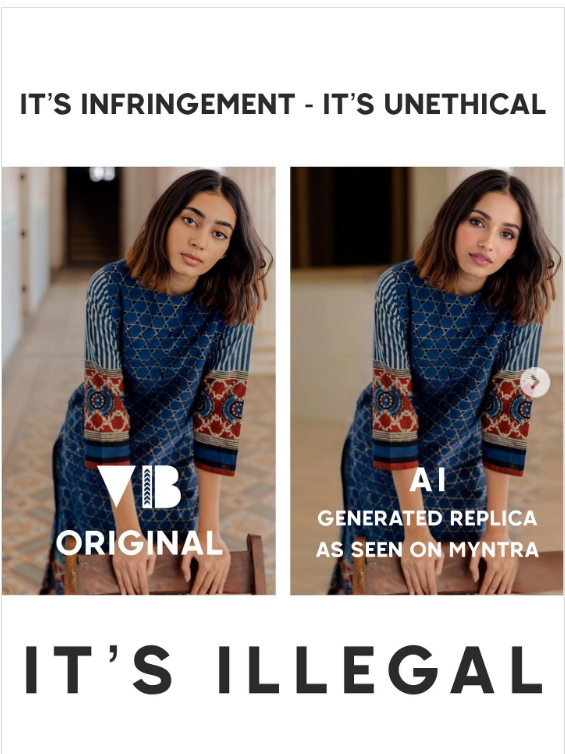There are no items in your cart
Add More
Add More
| Item Details | Price | ||
|---|---|---|---|
In the indian ecommerce, there has been a widespread issue that has been going on, where larger marketplaces and sellers are frequently using images that are created by small businesses without their permission.
This practice has became alarmingly common in the indian digital marketplace, with platforms like Amazon, Flipkart, and other top websites doing that.
There are different ways in which image theft can occur, which are as follows;
Direct copying:
Sellers download product images that suit their business, directly from small sellers' listings, and use them for their own website.
Cross-platform usage:
Here, images are copied from one marketplace to another one. For example, an image uploaded on Facebook might be used by a brand relevant on Instagram.


Catalog Hijacking:
Some sellers create duplicate listings using stolen images in an attempt to hijack the main product listing, and hence redirecting sales away from the original seller.
Wholesale Appropriation:
Wholesalers take images created by their retail partners and use them to sell directly to consumers, which cuts out the original sellers.
Even though after knowing the plagiarism and illegal usage of their resources, they are often helpless due to several reasons;
Limited Resources:
They often can't afford to pursue legal action or hire specialized IP protection services, because of lack of financial resources.
Lack of Awareness:
Many small business owners don’t understand what their copyright protections are or how to correctly enforce them.
Platform Limitations:
Most indian marketplaces have weak image protection mechanisms and slow response times to complaints regarding the digital world.
Volume Challenges:
With over a million listings every week, it becomes impossible for sellers to monitor and detect when their images are being used illegally.
Even though the situation might seem hopeless for business owners, there's actually some good news.
The Copyright Act, 1957 provides protection for original photographs and creative works, and making unauthorized usage of those images is considered a clear copyright violation.
 In other words, using other people’s photographs without the copyright holder’s permission is a clear violation of copyright, and if found out about the illegal usage then every copyright holder is entitled to appropriate compensation.
In other words, using other people’s photographs without the copyright holder’s permission is a clear violation of copyright, and if found out about the illegal usage then every copyright holder is entitled to appropriate compensation.
However, enforcement remains challenging due to these reasons:
- Lengthy legal process
- High litigation costs relative to potential damages.
- Difficulty establishing original ownership
- Cross-jurisdictional complications come when sellers tend to operate from different states.
Now, some might feel like just copying the images can't turn out to be a big issue, and amidst already big problems, this is the one that can be ignored.
So let me tell you the gruesome effects it has on small businesses.
1. Revenue Loss:
It is a revenue loss for those who don't steal images, as their competitors can appear equally professional without investing in photography.
2. Brand dilution:
Original creators lose control over how their products are presented, which in the long run damages their brand reputation.
3. Reduced creativity
The threat of image theft, which they have spent so many resources to built, demotivates the business owners to invest in professional photography and marketing materials.
And here are some of the common niches that are harmed severely due to this;
- Handicraft and artisan sellers
- Fashion and jewelry retailers
- Electronics and gadgets sellers
- Home decor and lifestyle brands
- Health and beauty product sellers
Most e-commerce platforms have reporting mechanisms for copyright infringement, but they don't effectively implement them due to the following reasons;
- Slow response times
- Inadequate verification processes
- Limited proactive monitoring
- Weak penalties for repeat offenders
Many platforms have also introduced watermarking tools and image recognition technology, but their implementation is still not achievable.
The Handicraft Seller’s Dilemma
A jeweler from Rajasthan, specializing in handcrafted jewelry, invested ₹25,000 in professional photography for his 50-product catalog.
Within a month, he found 12 sellers using his images across four platforms. Some of the sellers were claiming that the products were ‘imported’ or ‘machine-made’, and tagged them at dirt-cheap prices. Unfortunately, before she could take action, her sales dropped by 70%.
The Fashion Startup’s Struggle
A startup in fashion based in Mumbai had to reinvest in lifestyle photography as they had to scrape the ₹1.5 lakhs, which they had spent on the ethnic wear collection, on the photography that was stolen by reverse-engineering competitors who systematically designed similar products and used them for the sale of original photo shots of inferior duplicates.
It ended up rebranding and investing in new photography, post legal action became absolutely unviable from a cost and time perspective.
Automated Taking Tools
Smart software can now take pictures on its own from e-commerce sites, make them the right size, and even change them a little so no one notices. These tools can deal with thousands of pictures every day.
AI-Powered ChangeTop picture thieves now use AI tools to change stolen pictures just a little—changing backgrounds, changing colors, or adding/removing parts—making it harder for people to notice while keeping the picture's selling power.
Social Media GatheringAutomated tools scour social media sites for top-notch product photos, often going after small businesses’ Instagram and Facebook pages where the images might not have watermarks.
Watermarking: Applying visible and invisible watermarks on images of products might deter theft and establish ownership.
Documentation: Keeping records of the original photography shoots, timestamps, and raw files.
Monitoring: Making use of reverse image search tools to detect unauthorized usage.
Takedown Notices: Acting quickly in filing takedown notices as soon as the infringement is discovered.
Registration: Registering key product image copyrights to strengthen the legal position.
READ MORE: Freelancer Vs. Digital Marketing Agency – Which One Should You Start In 2025
- All emerging services for image monitoring based on AI.
- Image verification systems based on Blockchain
- Better industrial efforts for improved IP protection
- Improved policy and enforcement mechanism platforms
This issue has much broader implications for India's very fast-growing digital economy, where traditional mechanisms of protecting intellectual property have not kept pace with the advancement of technology and the size of the market.
The provisions of the law exist, yet as of now, they have not proven to be much of a help for small-scale business owners.
But as our digital market continues to expand, let's hope that one day, we do put an end to this broad light theft.

DAMINI TRIPATHI
Damini Tripathi, rocking the digital marketing scene for 5 awesome years. Started from scratch, now running my digital marketing agency and creating cool content too. She has been one of the fastest-growing digital marketers on the internet. Damini has also scaled multiple clients from ZERO —> HERO.